Black Grapes ice cream (or sherbet, if you like)
Grapes is a rare ice cream flavour to come across. Some say it is because grapes stop ice cream from freezing, others recall that grape ice cream will kill your dog. Sounds strange? Yes, let’s find out!
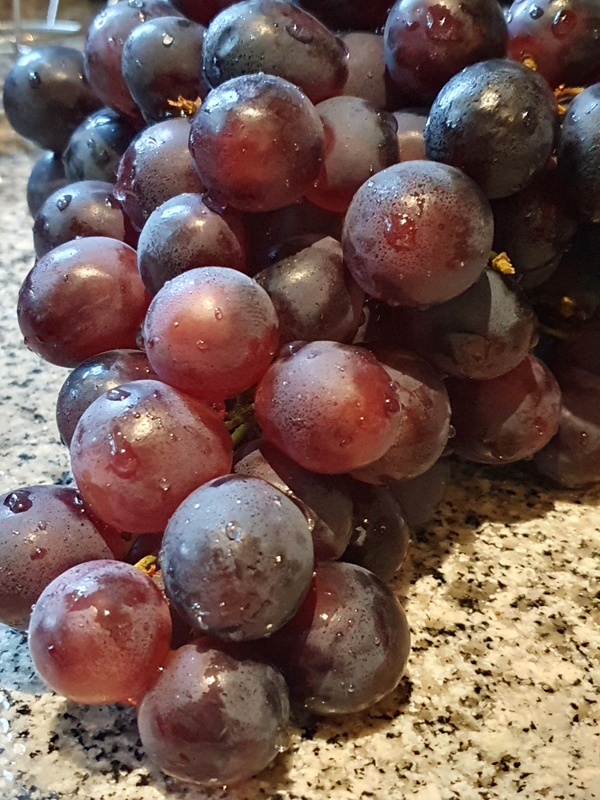
There are many varieties, but almost all grapes belong to the Vitis vinifera family.
On Grapes
Humans have cultivated grapes for about 6000-8000 years, and the practise is generally believed to have begun in the Middle East. Basically all ancient cultures, including the Persians, the Egyptian, the Greek, the Phoenicians and the Romans enjoyed the grapes. The tasty berries – both nice on their own and as basis for wine – continued to spread to other European regions and, eventually, to other suitable areas of the world.
Today, the top-producing grape countries are China, Italy, the USA, Spain and France. A lot of so-called “table grapes” (grapes for eating) have been bred to be seedless. Compared to “wine grapes” (grapes used for wine-making), table grapes tend to be less sweet, have thinner skin and – consequently – less flavour.
A thicker skinned-grape tend to be sweeter and more flavourful so for ice cream making, it is best if you can get hold of some ‘wine grapes’ (like Muscat, Zinfandel, Concord and their likes). Yes, they aren’t seedless but the result will make the extra work worth it!
Why is grape ice cream so rare?
Usually, one comes across three claims (expanded upon by Marissa Laliberte in this informative artice):
“Grape ice cream is lethal to dogs (and thus forbidden, at least in the US)”

Don’t feed your dog grape ice cream! Or chocolate ice cream! Or nut-ice cream!
There is particularly one widespread but untrue story about how Ben (of Ben & Jerry fame) once created a grape ice cream in order to court Jerry’s sister Becky. He succeeded, Becky happily let her dog have a couple of licks … after which the dog keeled over and died. As the story goes, the anthoycyanin (a substance in the grape’s skin responsible for, among others, the purple colour and much of the aroma/flavour) proved lethal to dogs. Ben’s budding romance crumbled along with any aspirations to make further grape ice creams, and – as the story goes – the US Health authorities put a ban on grape flavoured ice cream-products to protect the pets.
The particular story, and the claim that grapes have been forbidden in ice creams, are not true.
However, and while the danger appears to differ between individual dogs, both grapes and raisins can seriously harm your dog’s health and cause renal failure. But dogs should not eat chocolate and nuts either, so grapes aren’t unique in that sense.
“Grape ice cream simply can’t freeze”
False. Slightly related to Ben’s fictional struggle to create grape ice cream for Betty, the claim is that the grapes’ anthoycyanin and/or acidic nature simply makes any ice cream impossible to freeze. This is, however, not really true (even though the freezing may be somewhat more difficult, it is by no means impossible).
“Grapes contain too much water to freeze well”
Partly true. Grapes contain about 81 % water, which clearly is a challenge for ice cream making in general. And – apparently – particularly for large-scale industrial production, where the sheer quantities of the large batches makes it difficult to avoid icy chunks forming.
The good news? What may be difficult to deal with in an ice cream factory can better be done at home!
Home-made grape ice cream made easy
I wanted to see if it was possible to somehow preserve the “natural freshness” of the grapes, instead of going the “jam-cooking route” so often used in many recipes. Turning to the late Italian cooking icon Marcella Hazan, I found exactly what I was looking for!
The recipe requiers quite a lot of grapes, and preferably of the wine grape type. Luckily for me , here in continental Europe, the wine harvesting was in full swing so I could pick up a lovely bunch of black Muscat grapes in the supermarket.
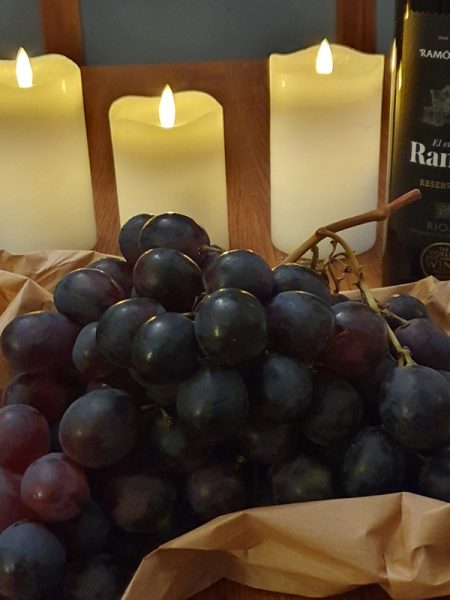
The recipe requires quite a lot of grapes, and preferably of the wine grape type. Luckily for me, here in continental Europe, the wine harvesting was in full swing so I could pick up a lovely bunch of black Muscat grapes in the supermarket.
In short summary, we will be making a sherbet – or a sorbet with a little added cream, if you will.
Start by making the (relatively small amount of) simple sugar syrup: mix the sugar and the water and let it boil until clear. Set aside and let cool down for now.
Why make simple sugar syrup when the grapes already contain so much water? Well, one aspect is economic – water is less expensive than grapes. Another aspect relates to the process: the only thing we will be cooking is the sugar syrup – the grapes will be spared all that heating.
Now, we need to de-seed our grapes. It may seem like hard work but is totally worth it – we wouldn’t like to let any bitter seeds spoil our upcoming delicious purée!
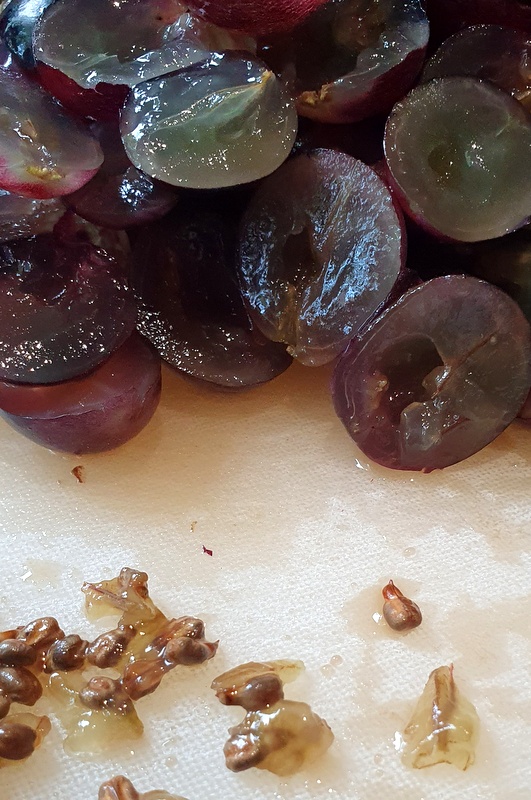
The seeds – if left in and crushed during the pureeing of the grapes – will spoil the nice flavour with their bitterness.
Once we have removed all the seed from the grapes, it is time to make our purée. We won’t cook the grapes, so you’ll need to pass them – skin and all (but no seeds!) – through (the small holes-setting of) a food mill or a suitable kitchen assistant. Don’t worry if some flecks of their skin gets through: It shouldn’t affect the final result in any negative way, but will rather contribute to the flavour and the overall consistency.
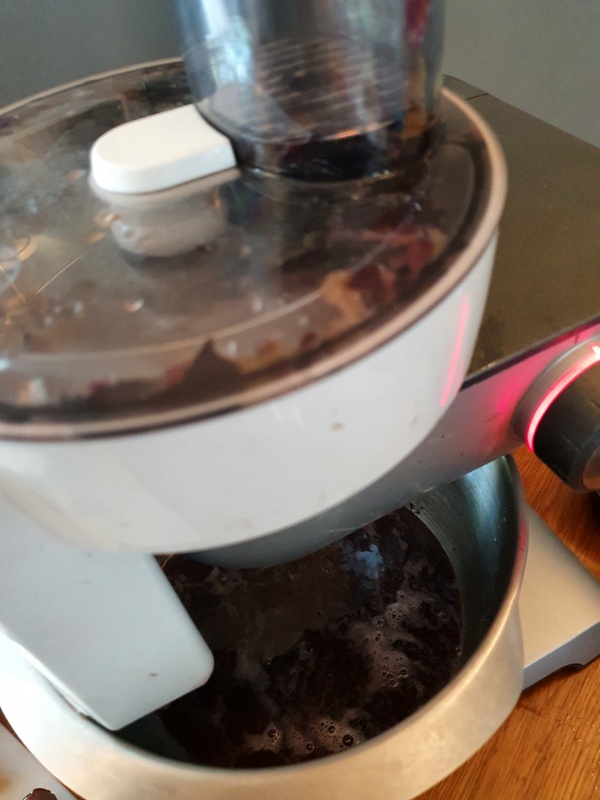
My trusty kitchen assistant’s shredding disc with small holes quickly turned the grapes into a (very juicy) purée.
To finalise our base, we now mix the three cold ingredients together: the simple sugar syrup, the pureed grapes and the small amount of slightly whipped cream.
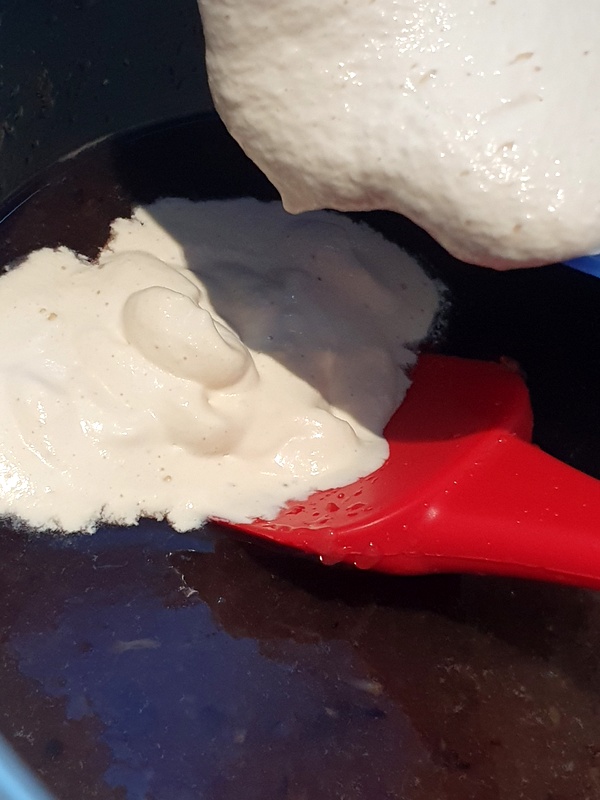
Just whip the cream slightly, and add it to the other base ingredients.
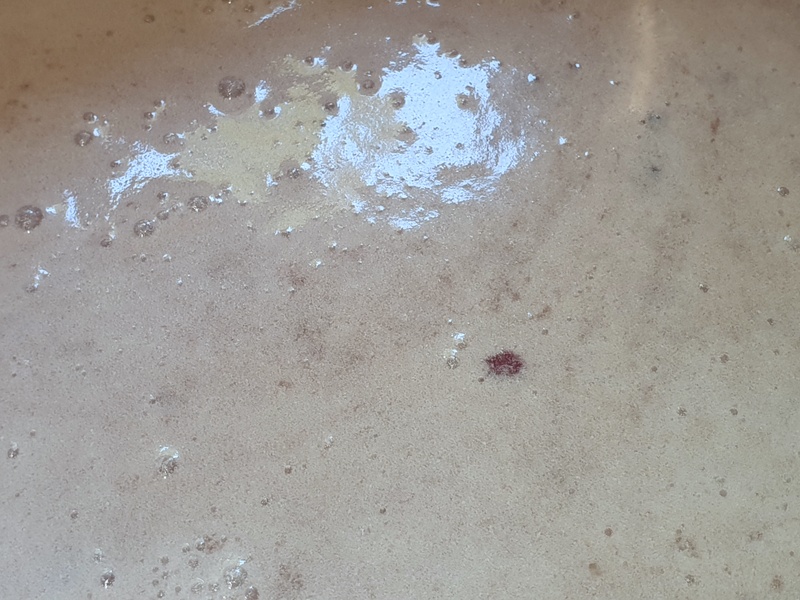
The combined result should look like something like this 🙂
Preferably set the base aside to chill in your refrigerator for a few hours, then churn it in your ice cream machine.
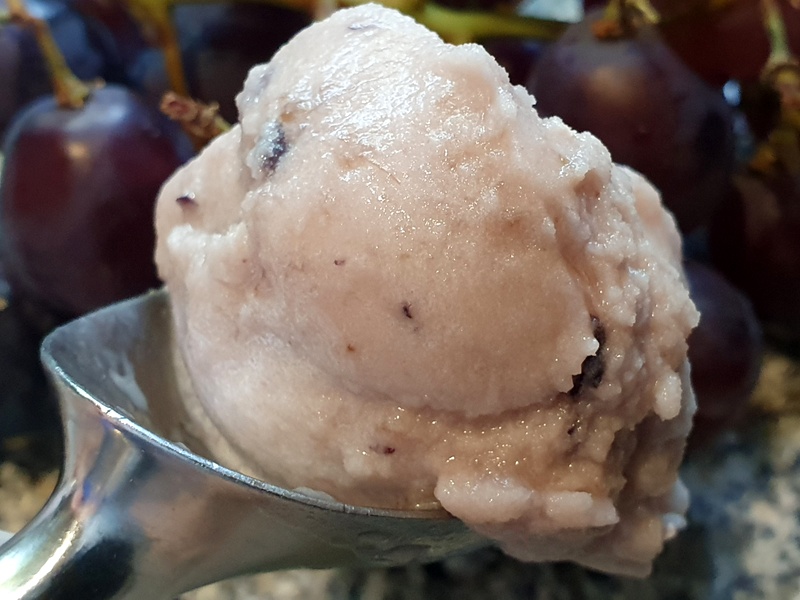
Just churned – a scope of delicious Grape sherbet!
The joys of home-made Grape ice cream
While industrial production may struggle to make grape ice cream, there is no reason for us at home not to give it a try. The sherbet – this particular crossing between a ‘true’ sorbet and a fully-fledged ice cream – proved to be an excellent and truly delicious experience! The grape flavour was natural, fresh and deep and the consistency proved pleasantly soft and scopable even after some time in the freezer. The addition of the small amount of cream really makes a difference too: even my wife – who doesn’t like sorbets – was very enthusiastic!
While the glorious grape sherbet proved to be a great hit in my household, I should point out that it is quite sweet. This was certainly not a problem for any of my happy tasters, but if you prefer your ice creams slightly less sweet, you might want to consider cutting down on the overall sugar a little (the overall consistency may possibly suffer a little – as we know, there is a lot of water to control in this creation – but if you plan on enjoying the sherbet soon after making it, it shouldn’t be too much of a problem 🙂 ).
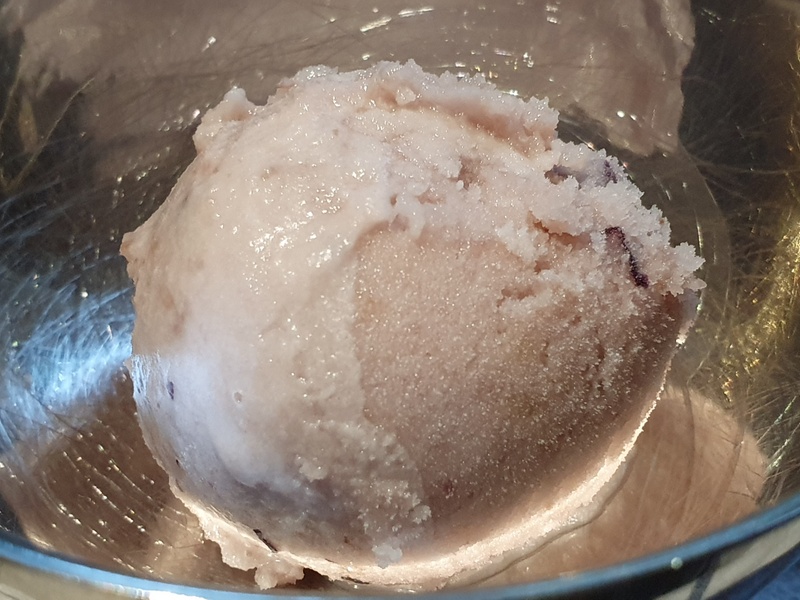
Yes, the grape sherbet keeps well in the freezer (no wonder, given the quite high amount of sugar used in the recipe).
- 675 gram black grapes (Muscat, Zinfandel, Concord or other similar flavourful "wine grape type"; avoid seedless varieties)
- 75 ml (1/3 cup) cream
- 150 ml (2/3 cup) water
- 225 gram sugar
- Start by making a simple sugar syrup: mix the water and the sugar and bring to the boil, whisking until the sugar has dissolved completely. Set aside to cool down.
- Wash the grapes in cold water and remove all seeds.
- Grind the grapes to a juicy puree with the help of a suitable kitchen assistant or a food mill (small holes-setting).
- Whip the cream lightly.
- Combine the simple sugar syrup, the pureed grapes and the lightly whipped cream.
- Preferably, let the base chill a few hours in the refrigerator.
- Churn the base in your ice cream machine (or still-freeze, using your household freezer).

Already Dionysus (of mythical Greek fame) knew it: Wine grapes are the best!
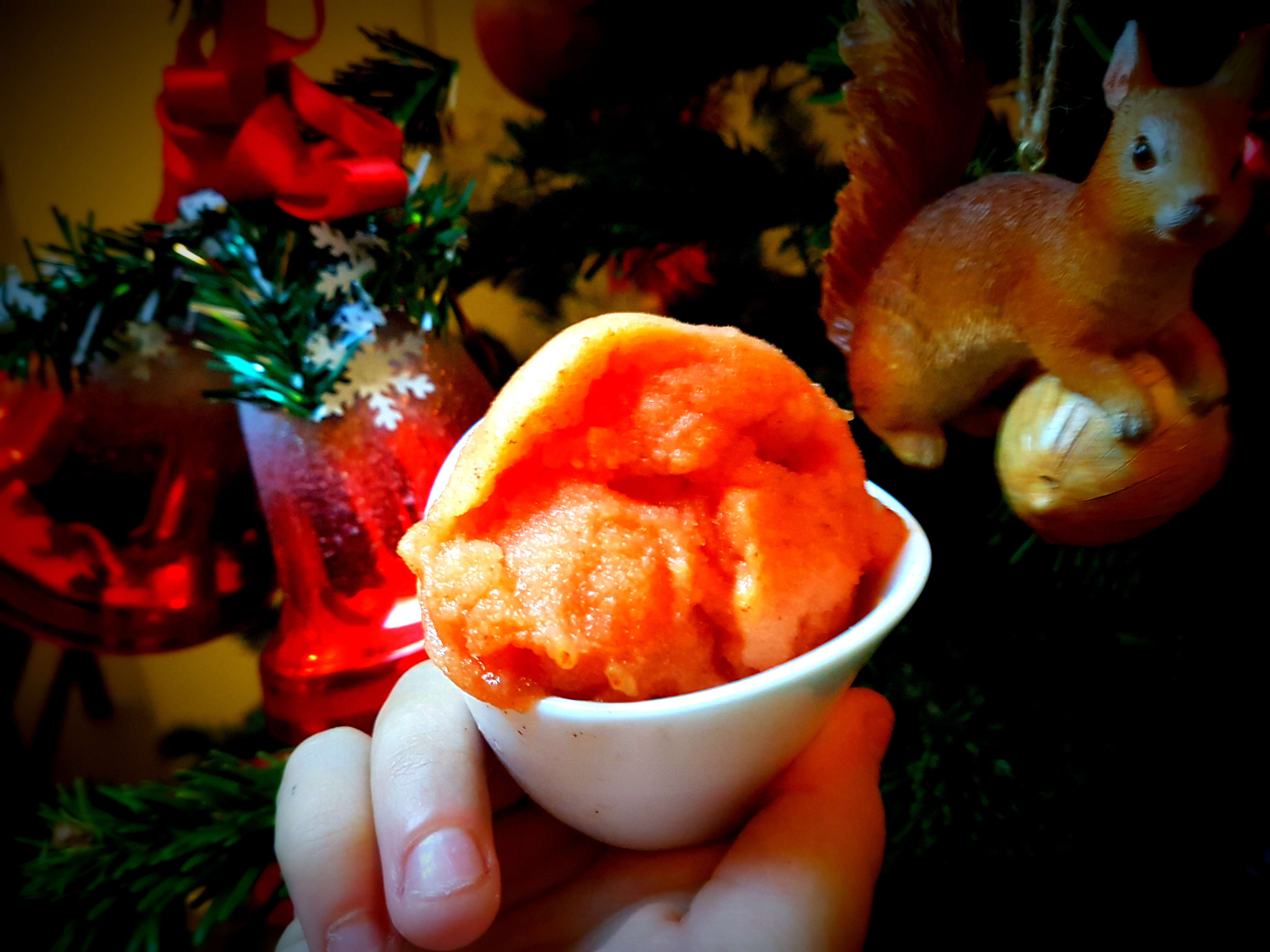
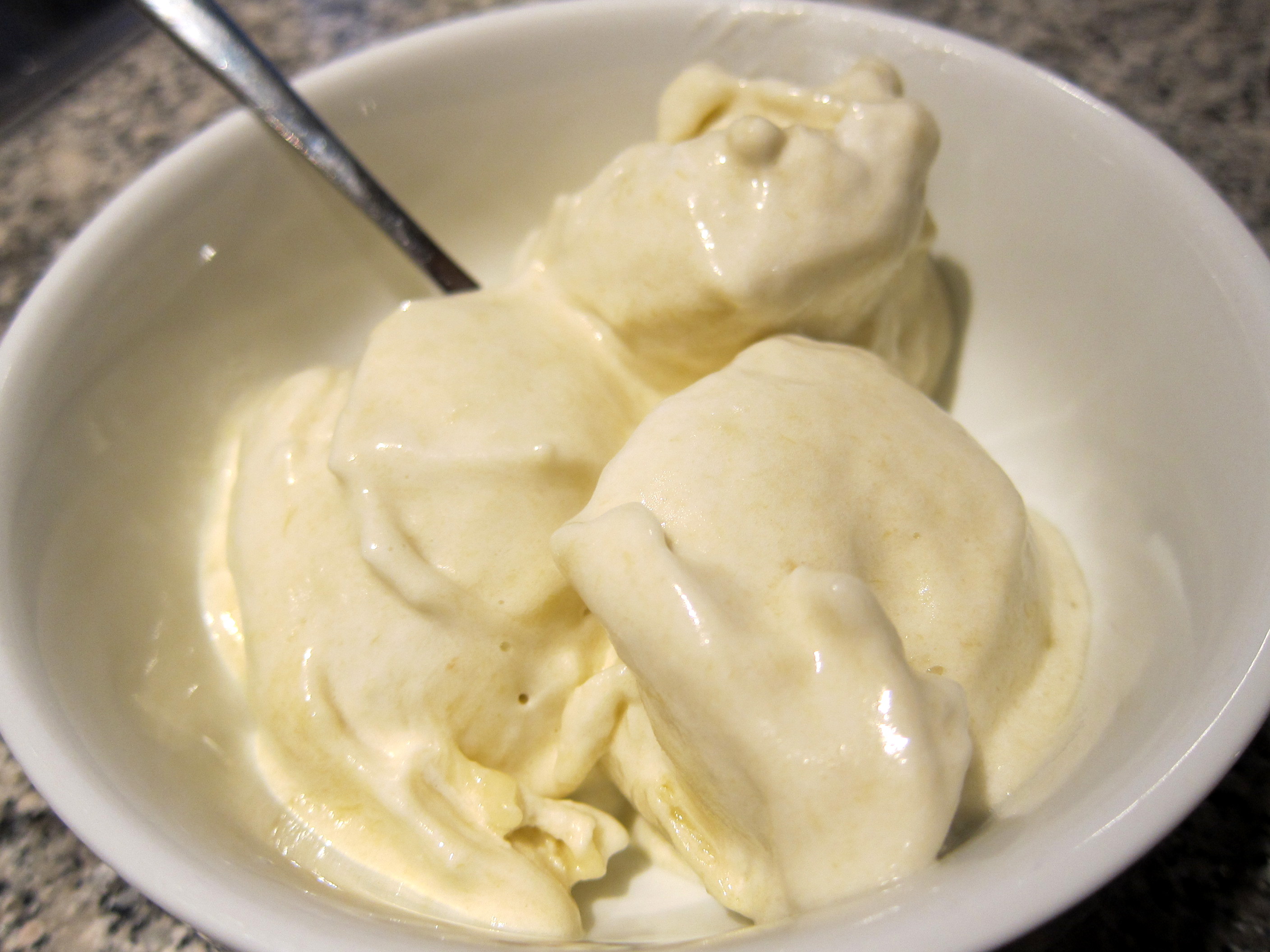
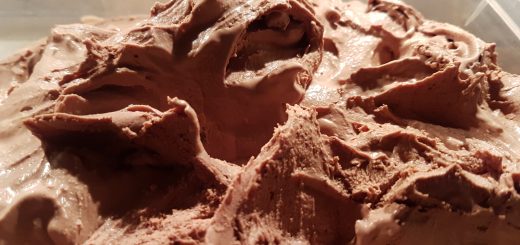


Must have great taste. I have never ever tried this way with grapes!
I read the blog and I love ice creams. Thank you for sharing.